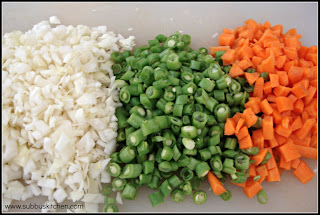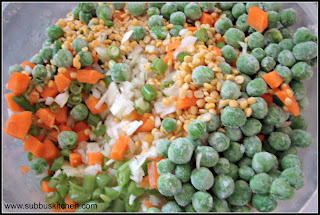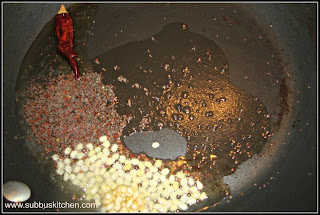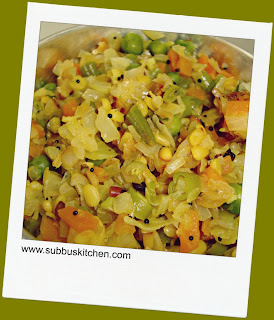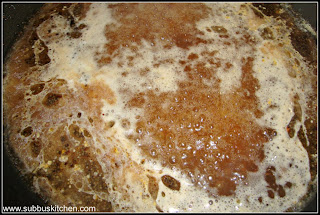Yellu vella podi is a simple neivedhyam on a Navaratri Saturday. We do this for neivedhyam on puratasi saturday also and pray to Lord Vishnu.
| Yellu Vella Podi |
Ingredients:
| White Sesame seeds(yellu powder) | 1/2 Cup |
| Grated Jaggery | 1 tablespoon |
| Cardamom powder | a pinch |
Method:
- Soak the sesame seeds in water for 10mins
- Drain the water and heat a pan and dry roast the sesame seeds till it starts to sputter
- Remove from flame and allow the sesame seeds to cool off
- Add the roasted sesame seeds to the mixer and grind it to a nice powder
- Now to the ground yellu(sesame seeds) powder, add the grated jaggery and cardamom and mix well
- The delicious and simple Yellu Vella Podi(Sesame Seeds jaggery powder) is ready for neivdhyam
Navratri also called as Dasara, meaning ‘ten days’, becomes dasara in popular parlance. The Navaratri festival or ‘nine day festival’ becomes ‘ten day festival’ with the addition of the last day, Vijayadashami which is its culmination. On all these ten days, the various forms of Mother Mahisasura-mardini (Durga) are worshipped with fervour and devotion

In Southern states of Tamil Nadu and to a lesser extent in Andhra Pradesh and Karnataka, the festival of Navrathri is called Kolu or Navratri Golu, where women set up decorated planks in a corner of the house and decorating it with dolls which are collected over the years.As per belief the concept of arranging these Navrathri dolls on the plank is to depict that Goddess Mahishasuramardini is sitting in her Kolu, prior to the slaying of the demon Mahishasura. Arranging Navrathri Kolu is also an event in itself it means inviting neighbors, friends and other relatives to visit your home and view the Kolu decorated. Pleasantries and small gifts are exchanged amongst women generally women exchange coconuts, cloths and sweets amongst themselves. Sumangali (married) women also exchange bags containing a small mirror, turmeric, comb, beetle leaves with supari.
Sundals are very popular among Navratri recipes/Golu Recipes as various varities of sundals are made everyday for Neyveidhyam and the same are distriubuted to the friends, relatives and neighbours who are invited to see the Golu. This special post is dedicated to Navaratri Recipes especially sundals. The recipes for various sundals are given below.
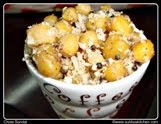 | Chickpeas Sundal This is one of the common sundal that will be prepared by all the devotees on the auspicious occasion of Navarathri. Its a great snack which is loved by all and its good for health too. |
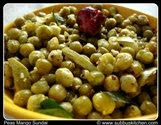 | Peas Mango Sundal Peas Mango sundal is very famous in chennai beaches. This is also a famous sundal during Navarathri. |
 | Gramdhal Sundal Its a quick sundal recipe as its preparation time is less compared to other sundal recipes. We don't need to soak this dhal for preparation. |
 | Black eyed beans (Karamani) Sundal It's yet another variety of sundal, which is very good for health. The method of preparation of this sundal is very easy, as we just need to pressure cook it and add the required spices. |
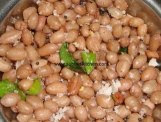 | Peanut Sundal Peanut sundal is something which i started making recently and it turn out to be very good. Now my kids take this sundal atleast once a week as a snack to the office. Why should we eat junk during the tea time when we have tastier yet healthier dishes are available ? |
 | Moong Dhal (Payatham Paruppu) Sundal Some people call this as 'Kosumalli". A handfull of moong dhal is added to the vegetables curries like carrot, cabbage,etc. Here, it has a direct focus for sundal. It's also one of the very easy sundal recipe, as we don't need to soak this dhal and hence the preparation time is very less. |
 | Green Gram Sweet Sundal Enough of salt & spice sundal. Let's make the sweet sundal for today. This is the sweeter version of Green Gram dhal sundal. |
 | Green Gramdhal Sundal It's yet another variety of sundal made using Green gramdhal. |
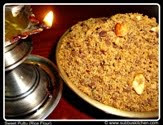 | Sweet Puttu It's one of the sweet recipe made using Navarathri. I make this on Fridays during Navarathri. It requires relatively more time, cumbersome process and more patience, but it's taste is awesome. This is a traditional dish made using Rice Flour. |
 | Rawa Appam As its name suggest, its made using Rawa. Its relatively easier to make compared to the appam made using Rice flour. The taste is also equally good. We are adding the sugar in the Rawa appam instead of Jaggery as we add in the Rice flour appam. |
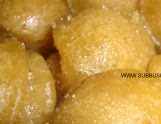 | Appam Sweet appam or Vella appam is a popular dish in tamil nadu which is made not only for Navarathri, but for many festivals for Neyvedhyam. |
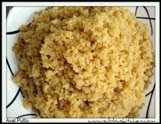 | Aval Puttu Its a sweet neyvedhyam, we prepare for Krishna Jayanthi. But you can also make the same for Navarathri. Its very easy compared to Rice Flour Puttu |
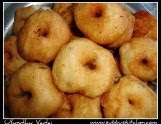 | Vadai Vadai is a wonderful snack, which can also be used for neyvedhyam for almost all the festivals. Its crispy and yummy. |
 | Mixed Dhal Sweet Sundal Its a sweet sundal made using mixed dhal. |
You may also interested to see
Another variety of spicy vadam/vathal. We can use this vadam flour to make ommapodi or thenkuzhal vadam.
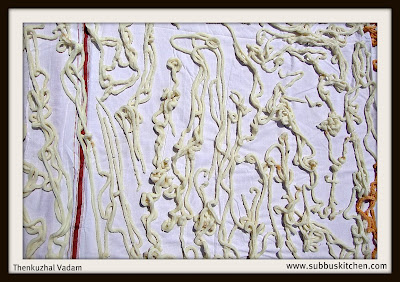



Ingredients:
Raw Rice - 4 Cup
Javvarasi(Sago) - 1 Cup
Salt - To Taste
Green Chilli - 10
Hing - 1 tablespoon
Batter Preparation Method:
- Soak the raw rice in water for 30 minutes.
- Heat 1 cup of water and when it comes boil, add it to the bowl having Sago(Javvarasi) and close the bowl.
- After 30 minutes, rinse the rice and strain the water and grind it in grinder or mixer to a nice paste. Take this in a separate vessel.
- Add the Sago to the mixer and grind it to paste and add this to rice batter and stir well to mix both rice and sago batter.
- Grind the green chillies, salt and hing to a nice paste and add it to the sago batter.





- Take heavy bottomed pan or cooker. Heat 1 ratio of water based on the batter and when it starts to boil, take 2 tumbler of water and keep it separately
- To the remaining boiled water, add the rice-sago batter and stir well
- Batter should become thick as well as cooked well
- If needed, we can add the 2 tumbler of water slowly to cook the batter
- Add salt to the batter and stir well. Salt should be less for vadam because when we dry the vadam and fry it in oil, salt will be more
- We need to stir the batter well so that it gets tighten up and becomes thicker .
- When the batter is cooked well, switch off the flame
- Cool off the batter and we can start making vadams
- Take a clean white towel and place it in hot sun and take ommapodi mould and thenkuzhal mould. Add 1 handfull of batter to the press and press it to make ommadpodi and thenkuzhal vadam
- Let the vadam dry in sun. Allow it to dry for 1 day
- After the vadams are dried completely, we can store it in a tight container and fry it when we require

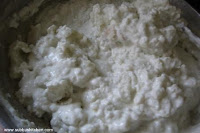
If you are in Tamil Nadu during summer, you might have noticed the road side vendors selling Koozh with colourful side dishes. Yes, as most of you know Ragi Koozh is a perfect cooling drink and its very good for the health. I know in many families they substitute koozh for the breakfast. The Koozh can be topped with pickle, sundai kai vatral, vadam, onion, etc.. Believe me.. it tastes divine.
 Ingredients
Ingredients Ragi Flour - 1cup
Cooked Rice - 1/2 cup
Salt - to taste
Butter milk / curd - 1/4 cup
Finely chopped onion - 1/4 cup
Method
The day before preparation (Dough preparation and Fermentation)
- Mix Ragi Flour with cooked rice and salt. Add water to make idly batter consistency. Mix well so that there are no lumps.
- Keep this mixture aside for 3-4 hours for Fermentation.
- After 3-4 hours, heat the heavy bottomed pan. Measure the Ragi Mix and add same amount of water in the pan.
- When the water starts boiling add the Ragi Mixture. Cook the mixture in the medium flame for about 15mins - 20 mins. Make sure that you stir continuously to avoid burning. In 15-20 mins it will become thick batter consistency.
- Switch off the flame and close the pan. Keep it overnight for fermentation. It increases nutritional benefits and taste.
Next Day - Make a Koozh:
- For 1 cup of Koozh, add 3/4 cup of dough (that you prepared yesterday and kept for fermentation) and add 1/4 up of butter milk/curd. If required add water.
- Mix well.
- Serve with Vadaam / Pickle / chopped onion.
Note : Instead of adding the cooked rice, you can also add the raw rice in the boiling water before adding the ragi mix. When ragi is cooked, the rice will also be cooked.
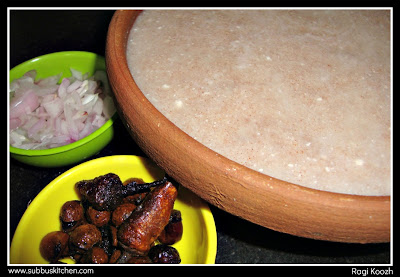
Kadhamba curry is nothing but a mix of many vegetables. Here i have mixed beans, cabbage, carrot and peas. This is all time favourite for my husband and i believe many of us like this too as it is rich in combination of vegetables. This is again simple to make and kadamba curry would be helpful with respect to the quantity if we have guests at our home
Ingredients:
Method:
 |
| Cabbage Kadhamba Curry |
| Cabbage | 1/4 kg |
| Beans | 20 |
| Red Chill | 1 |
| Oil | 2 teaspoon |
| Carrots | 3 |
| Curry Leaves | Few |
| Urid Dal | 1/2 teaspoon |
| Mustard Seeds | 1 teaspoon |
| Salt | To Taste |
| Moong Dal | 4 teaspoon |
| Grated Coconut | 2 teaspoon |
Method:
- Clean the beans and carrots and peel the carrot skin
- Finely chop the cabbage, beans and carrots
- To this add moong dal and peas and keep it ready
- Heat oil in a heavy bottomed pan, add mustard seeds. When the mustard seeds starts to sputter, add urid dal and broken red chilli and fry it till the dals turn golden brown color.
- Add the vegetables and mix it well in the oil.
- Sprinkle little amount of water for the vegetables to cook and add salt
- When the water evaporates, add little oil and allow the vegetables to cook completely
- Finally add grated coconut and mix well and remove from flame

- The yummy kadamba curry is ready to serve with any kuzhambu or rasam
Anjaraipetti Kuzhambu, a slight variation of traditional vathakuzhambu. The reason for this name is that we use most of the ingredients present in Anjaraipetti. Nowadays the trend is changing and none of us use Anjaraipetti and we moved to use tupperware and other air tight containers. Whatever the container is, we have to use all the ingredients to make this mouth-watering recipe. Try this and let me know your comments!
 |
| Anjaraipetti Kuzhambu |
Ingredients:
| Tamarind | 1 lemon size |
| Salt | To Taste |
| Green Chilli | 2 (Optional) |
| Oil | 2 teaspoon |
| Ladys Finger or Drumstick | 10 medium sizes pieces |
| Curry Leaves | Few |
| Hing | a pinch |
| Mustard Seeds | 1 teaspoon |
Ingredients For Grinding:
| Thoor Dal | 1 teaspoon |
| Urdal | 1 teaspoon |
| Red Chilli | 6 |
| Oil | 2 teaspoon |
| Moong dal | 1 teaspoon |
| Gram Dal | 1 teaspoon |
| Coriander Seeds | 2 teaspoon |
| Pepper | 1/2 teaspoon |
| Raw Rice | 1/2 teaspoon |
| Fenugeek seeds | 1/2 teaspoon |
Method:
- Soak the tamarind in water and extract the juice and keep it aside
- Dry fry raw rice and fenugeek seeds in a pan and take it in a mixer
- Pour some oil and add the rest of the grinding ingredients and fry till the dals turn golden brown color
- We can also fry each ingredient separately so that they are evenly fried. Then take all these in a mixer
 |
| Frying |
- Grind the ingredients to a nice powder
- In the pan, pour some oil and fry the ladys finger( we can also use brinjal or drumstick). Once it is cooked, take it in a plate and keep it aside
- In the same pan, now add oil and when the oil is hot, add mustard seeds.
- When the mustard seeds starts to sputter, add curry leaves, hing and vertically split green chilli and fry for a minute
- Now add the tamarind extract and salt. Allow the mixture to boil
- Now add the ground kuzhambu powder and stir well to avoid lumps. Immediately we need to stir after adding the powder as the powder tend to form lumps.
- Let the kuzhambu boils for some time.
- Finally add the fried ladys finger and mix well. If you plan to use drumstick, then we should add the fried drumstick with the tamarind juice itself.
- The delicious Anjaraipetti Kuzhambu is ready to serve with hot rice. This goes well with appalam/pappad or potato fry.






